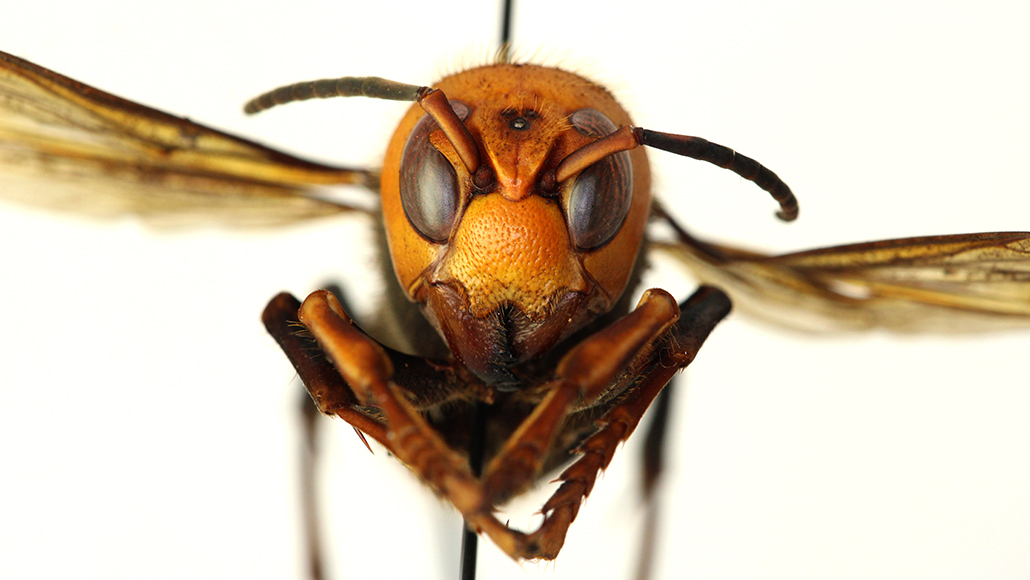
Asian giant hornets (one shown) may find lots of suitable habitat in the Pacific Northwest, but much is unknown about how they spread.
Quinlyn Baine/WSDA
The race is on to keep Asian giant hornets from spreading in the Pacific Northwest.
After successfully tying a tiny tracker on a hornet with dental floss and following it to a tree in Blaine, Wash., officials have destroyed a nest full of the insects. It was the second nest found in North America — Canadian officials eradicated one in 2019 near a public footpath in a wooded park in Nanaimo on Vancouver Island — but experts suspect there could be more.
Since first appearing in 2019, numerous giant hornets have turned up in the region. An earlier attempt to track a worker to its nest failed when glue used to attach the tracker gummed up the hornet’s wings.
This time, though, the tracking plan worked. The hornet led the team to a nest about three meters up in a hollow in the trunk. The team was prepared for the worst and wore protective suits to extract the hornets. But the cold weather made the hornets docile, Sven Spichiger, managing entomologist with the Washington State Department of Agriculture in Olympia, said in a news conference on October 26.
The team stuffed foam into the tree above and below the nest, then wrapped the tree in plastic to prevent hornets from escaping. It vacuumed 85 hornets from the nest, and pumped in carbon dioxide to stun and kill any that remained.
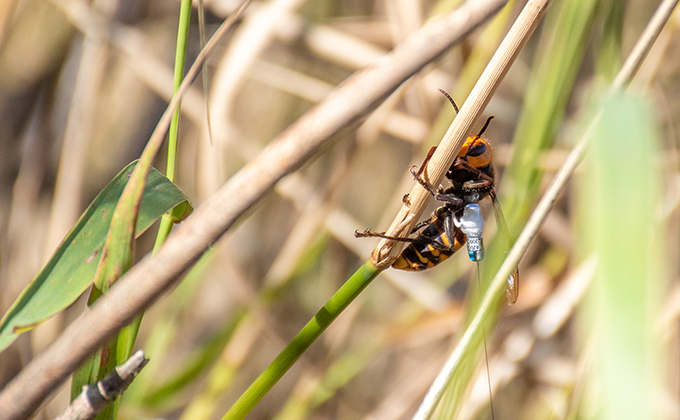
Officials successfully tracked a giant hornet back to its nest up in a tree using a radio tracker tied on with dental floss.WSDA 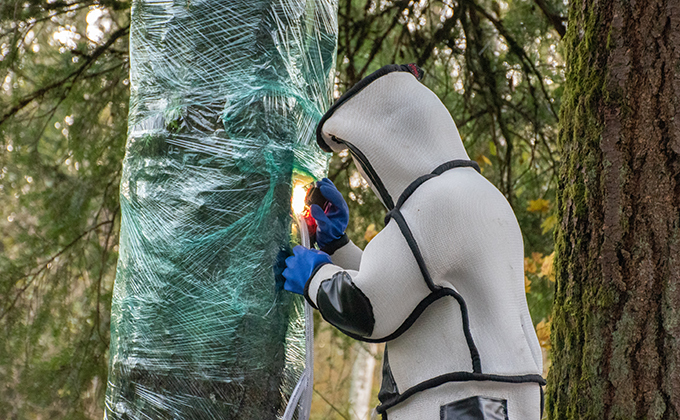
To eradicate the nest, officials donned protective suits and sealed off the tree using plastic wrap, to prevent hornets from escaping. Here, after having vacuumed out most of the hornets, one official pumps carbon dioxide into the nest to stun and kill any still inside.WSDA 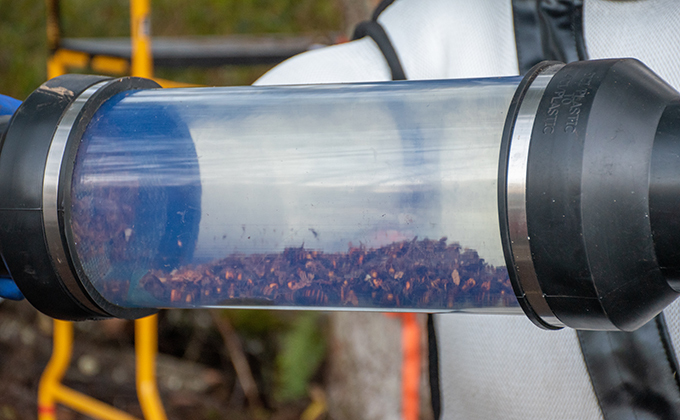
A canister holds a whopping 85 Asian giant hornets that were sucked out of their nest. An additional 13 hornets were captured live the day before.WSDA
Officials soon plan to cut down the tree and examine the nest to see if hornets that can start their own nests have already hatched. That usually happens in mid- to late October, says department spokesperson Karla Salp.
The department is also using live traps and “sentinel hives” — honeybee hives with a grate that allows bees to pass through but stops the larger hornets — to attract more hornets. The goal is to find and destroy any other nests that remain.

That eradication effort is urgent thanks to the insects’ reputation: The world’s largest hornets (Vespa mandarinia) have been dubbed “murder hornets” in part for their deadly assaults on honeybees (SN: 5/29/20). Now a new study maps where the giant hornets could spread if left unchecked.
Asian giant hornets thrive where it’s mild and rainy — and that makes large swaths of the Pacific Northwest prime real estate for them. Farther afield regions of the United States — including along the East Coast — could potentially support the hornets, but it’s unlikely the insects could fly that far on their own, researchers report online September 22 in the Proceedings of the National Academy of Sciences.
The mapping efforts are important because “we really don’t know anything about how this species spreads,” says Chris Looney, an entomologist with Washington’s agriculture department. Details like how fast the hornets can fly and how their preference for underground nests affects their potential to spread are unknown, he explains. “That’s the kind of maddening lack of information that makes responding to this species so challenging.”
But by looking at what sorts of habitat conditions — including rainfall and temperature — the hornets prefer in their native range in Japan, South Korea, China and several other East Asian countries, Looney and colleagues mapped regions of the United States where the hornets might be able to survive. Then, the researchers simulated the insects’ spread using information on how the Asian giant hornet’s smaller relative, V. velutina, has invaded Europe. That hornet spread at an average rate of about 100 kilometers per year.
New niches
Using the known ecological niche of Asian giant hornets (Vespa mandarinia) and the average rate of the spread of a related species, V. velutina, in Europe, researchers have mapped the giant hornet’s potential spread in the next 20 years, if the species isn’t eradicated. The hornets have been found so far in Washington state and just across the border in British Columbia, Canada (circles). Assuming the hornets travel under their own wing power at a rate similar to or slower than V. velutina, giant hornets could reach southern Oregon in around 13 years (map at left). If they spread at the maximum rate of V. velutina, as well as hitch rides on vehicles, the hornets could reach southern Oregon in about 10 years, and as far north as Glacier Bay, Alaska in about 20 years (map at right).
Where Asian giant hornets could spread within 20 years
On their own
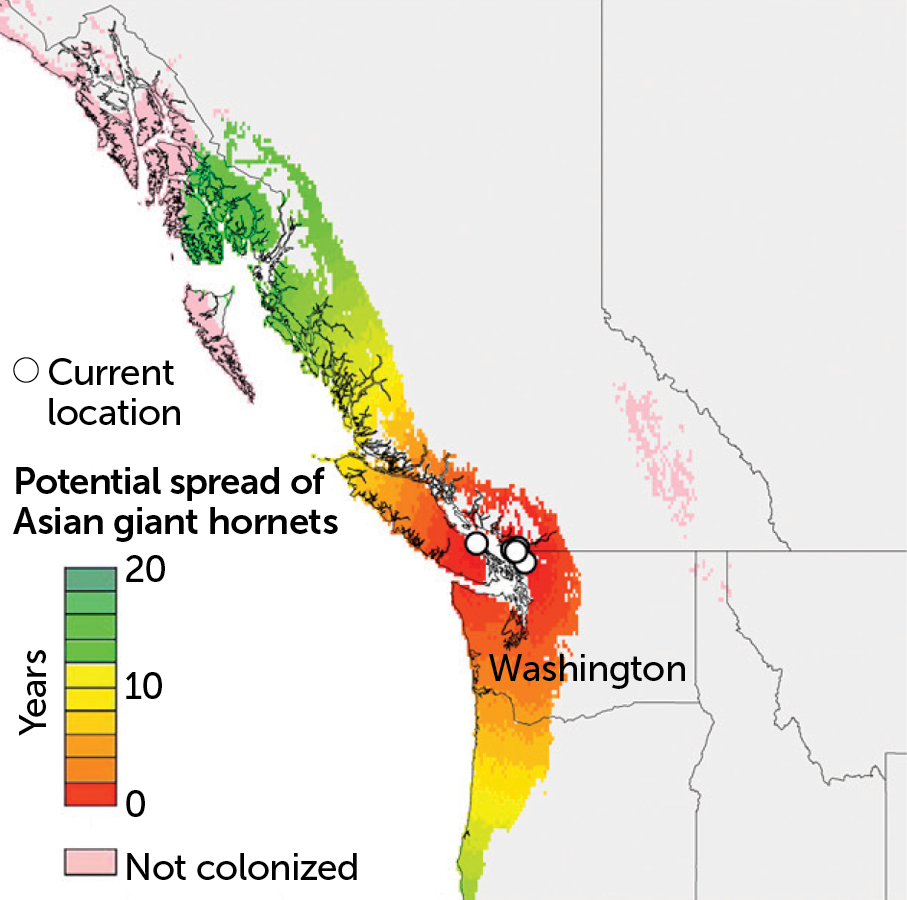
With human aid
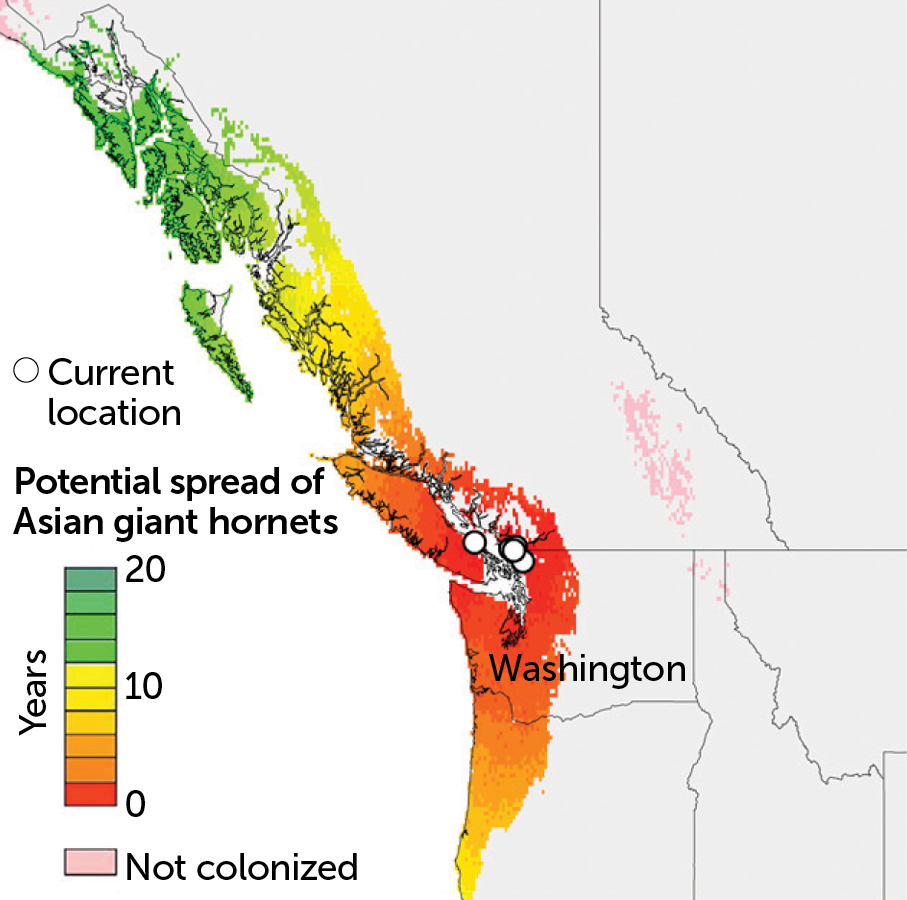
“There is a considerable amount of suitable habitat along the West Coast and our dispersal simulations of how quickly the invasion might spread were surprising to us,” says David Crowder, an entomologist at Washington State University in Pullman.
Simulations of a worst-case scenario showed that about half of both Washington and Oregon offer suitable habitat. The hornets could reach Oregon on their own in 10 years. In 20 years, the hornets could reach eastern Washington and farther into British Columbia. Parts of Northern California and northern Idaho are at risk, too. And while much of the eastern United States has suitable habitat, “it is highly unlikely, if not impossible, that the hornet could traverse the continent on its own, given the lack of suitable habitat in much of the central U.S.,” Crowder says.
Still, this research is “telling a more positive story than it’s being made out to be,” says entomologist Douglas Yanega from the University of California, Riverside. “They’re talking about two decades before [the hornet] will reach the limits of its distribution. That’s a very long time.”
And, he notes, there’s still time to stop the insects in the United States. “The actual number of colonies out there is so small that if we can find a few of those colonies, we might be able to completely eradicate them,” Yanega says. “It doesn’t look like the kind of situation that’s capable of exploding on us, and it certainly hasn’t so far.”
Sign up for our newsletter
We summarize the week's scientific breakthroughs every Thursday.






